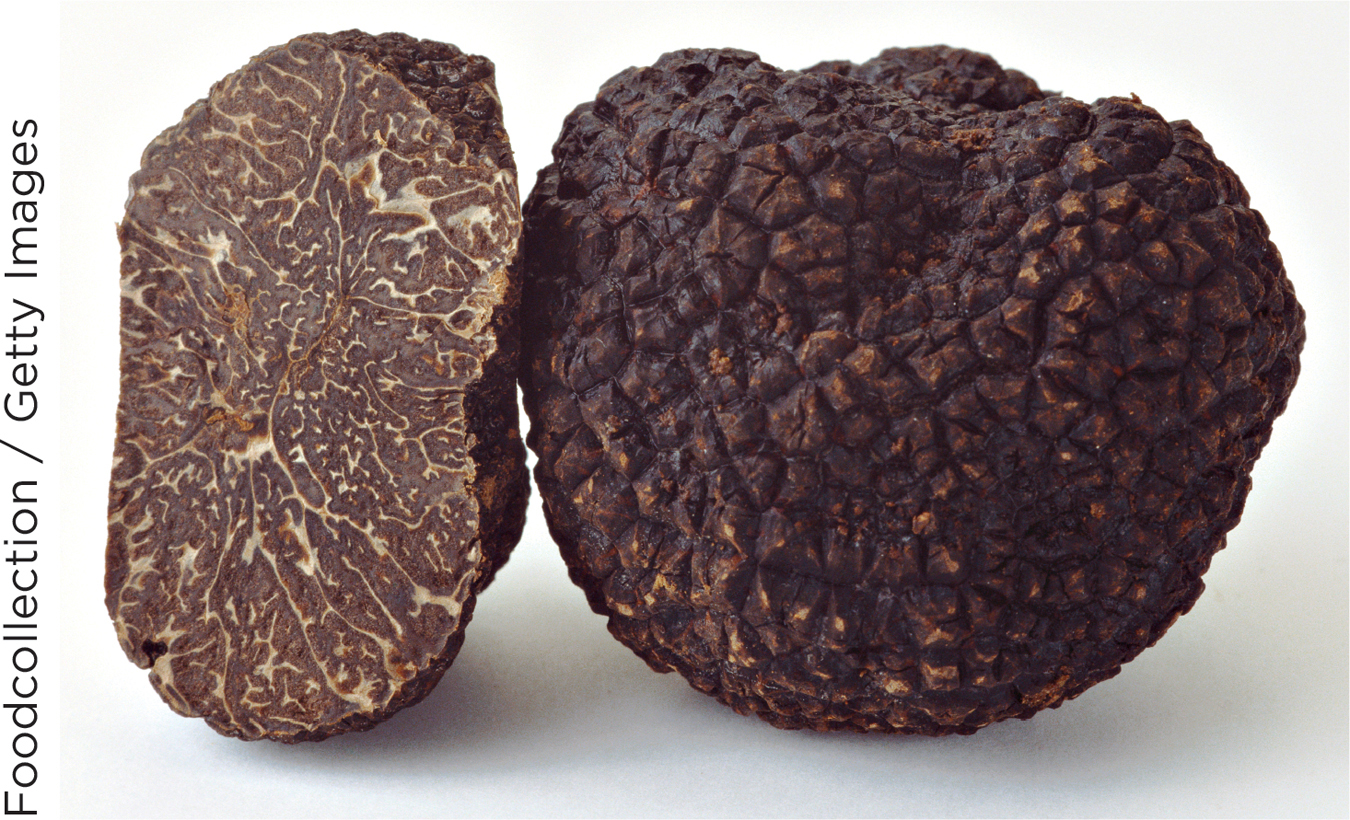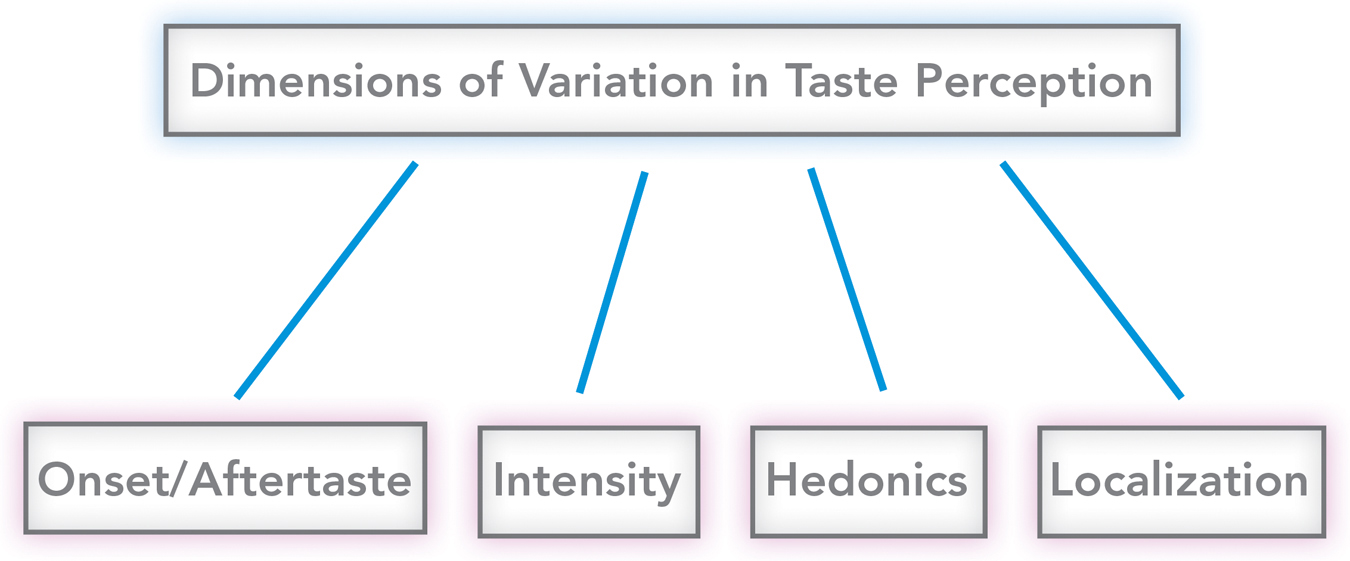5.6 The Gustatory System
Victory is sweet. Defeat is bitter. When the salesman tried to trick you into paying too much for a used car, the experience left a bad taste in your mouth. When your relationship broke up and your ex said, “I never really cared about you anyway,” it was just sour grapes. The psychological experience of taste, which is produced by the gustatory system, is so central to human experience that we use tastes as metaphors for discussing life’s ups and downs.
Taste, in fact, may be necessary to life itself. People who lose their sense of taste have trouble getting themselves to eat, despite needing nutrition to live. One such person, who lost gustatory ability after radiation therapy for cancer, said that, without taste, being served a meal is like “being presented with a piled-
If, by a mighty effort, the “cinders” are forced down with copious fluid, the consequences are acute indigestion or vomiting. … [I]f there is anything objectionable to feel (such as gristle in [meat]) a sort of panic nausea may be the next reaction.… The patient is not hungry anyway, and it is easier to starve.
—MacCarthy-
We need tastes. The gustatory system gives them to us by responding to the chemical properties of foods and sending these responses to the brain.
Gustatory Perception
Preview Questions
Question
 Besides salty and sweet, what are the other types of tastes we can detect?
Besides salty and sweet, what are the other types of tastes we can detect?
What the heck is umami?
Question
 Why don’t all salty foods taste the same?
Why don’t all salty foods taste the same?
Question
 What is the difference between flavor and taste?
What is the difference between flavor and taste?
Question
 What is a supertaster?
What is a supertaster?
When you try different foods, your perceptions of them differ in two ways:
Qualities: You notice different qualities; that is, different foods have entirely different types of tastes.
Dimensions: Taste experiences differ along a number of dimensions. For example, some tastes are more intense than others.
194
Let’s review these two aspects of taste perception and then discuss flavor, an experience that combines taste and smell.

TASTE QUALITIES. Humans perceive five distinct taste qualities. Even complex food tastes—
Sweet: Most people—
in fact, most mammals— are attracted to sweet tastes. This makes sense when one considers evolutionary processes. Foods that taste sweet are high in simple carbohydrates, which provide energy the body needs. The ability to detect these sweet, high- carbohydrate foods thus was adaptive over the course of evolution. Salty: Salty tastes come from foods and flavorings containing the chemical sodium. (Salt itself is, chemically, sodium chloride.) Organisms need sodium to maintain normal bodily functioning. Again, our liking for saltiness makes sense evolutionarily; across evolution, it was essential for organisms to develop the ability to obtain sodium, through the taste experience of saltiness.
Bitter: Many potentially edible substances in the natural world that are poisonous taste bitter. The gustatory perception of bitterness, then, appears to have evolved as a “warning signal.” It protects organisms against edible dangers.
Sour: Sour tastes are triggered by foods that, chemically, are acids. Lemons, for example, contain a high level of citric acid. The ability to detect sour tastes may have evolved because sourness signals the degree of ripeness of fruits, which change in acidity during the ripening process.
Umami: Scientists only recently discovered and named a fifth taste: umami, which corresponds to the taste we usually call “savory” (Li et al., 2002). The rich flavor of a beef stew includes the taste umami. A refreshing fruit salad or a chewy marshmallow do not. Umami is triggered by high levels of protein in food. This taste experience thus may have evolved to help organisms identify and ingest the protein they needed for bodily growth.
When was the last time you experienced umami?
DIMENSIONS OF GUSTATORY EXPERIENCE. All salty tastes are not the same. Neither are all sour tastes, nor gustatory experiences of the other taste categories. Tastes also differ along a number of taste dimensions.

Four taste dimensions describe variations in gustatory experience (Figure 5.41). Onset/aftertaste describes taste experience across time. For example, some tastes linger, whereas others “vanish” soon after a food is swallowed. Intensity describes the strength of the gustatory experience. Two foods might both be sour, but one could have a much greater intensity of sourness than the other. Hedonics refers to how much you like the taste. Hedonics and intensity are often related; you might like salty potato chips—

195
FLAVOR. We have been considering perceptual systems one at a time, but sometimes they work together. A prime case of this is the perception of food.
Imagine that you’re trying to guess the seasonings in some food (e.g., “What’s in that tomato sauce?”). Some of the perceptual information you gather comes from taste. But, some of it comes from smell—
In the experience of flavor, your perceptual systems integrate information about taste and smell to produce a coherent perceptual experience (Auvray & Spence, 2008). You don’t have two separate experiences of a food product, one olfactory and one gustatory (“Hmm, I smell some garlic somewhere”; “Oh, and I taste some garlic in my mouth”). You have one integrated perceptual experience of the food (“There’s garlic in that soup”).
Both everyday observation and scientific findings show how smell and taste interact. If you have a stuffy nose from a cold, or just hold your nose when eating, you cannot perceive the flavor of food as keenly as normal. Research shows that smells influence tastes. For example, a food’s odor can influence how sweet it tastes (Auvray & Spence, 2008).
SUPERTASTERS. Not everyone’s experience of foods is the same. Some of us are supertasters: people who have greater sensitivity to tastes than others.
Supertasters were discovered in research by psychologist Linda Bartoshuk and her colleagues (Bartoshuk, 2000). In their studies, participants were asked to rate, on a measurement scale, the intensity of their experiences when tasting various substances. A subset of individuals provided extremely high ratings of intensity. There were two possible interpretations of this result: (1) These people were more sensitive to tastes than others; or (2) they were no more sensitive to tastes than others, but merely tended to make more extreme ratings when filling out measurement scales during psychology experiments.
To determine which interpretation was correct, the researchers devised a clever new measurement procedure (Bohannon, 2010). They asked people to rate the most intense sensation (e.g., an intense pain) they ever experienced, and then to rate the intensity of taste experiences. The use of two ratings allowed the researchers to control for people’s general tendency to make low-
Are you a picky eater? Perhaps you are a supertaster! Supertaster tests can be found easily on the Internet.
WHAT DO YOU KNOW?…
Question 12
8NhjOkdnMIkDTm33p8gUjWLuwp8d8WxYuTTOpC2ussR1Um3n3LBuIp1KtBG+MPbWO7Xe2wgdmf5/QOaW4YCuGQ85wvWYX5uvPpg4b9s/tuzr6dxjelfG+ccdNPgvqPBZlVNmWsR2s7Ss7nd9hW83v+8GSO5WDbyjYN9v75+XZLcwf1wij1wy+P1EllTQdqLchBXD5AmNmJg6IwCB+hkxsfoVaoiacSB23AbD4BA4vXWnuK6F7QDTUS4WsGDyJBN3AtsA7ImIyB+QUcdkbnO3iV5xILGqF/Rj6phuGaY1MYM=From Mouth to Brain: Biological Bases of Gustation
Preview Question
Question
 Through what biological process are we able to convert gustatory information from our mouths to our brains?
Through what biological process are we able to convert gustatory information from our mouths to our brains?
196

In taste perception, connecting psychological phenomena to biological mechanisms is straightforward. The biology of gustation directly explains many of the psychological phenomena you just learned about.
The first step in getting gustatory information from mouth to brain involves taste receptors, which are cells that are stimulated by chemical substances in food. When stimulated, taste receptors release neurotransmitters that begin the process of transmitting gustatory information to the brain (Smith & Margolskee, 2001). Taste receptors are bundled together in taste buds, each of which contains about 50 to 100 receptor cells. Taste buds are found primarily on the tongue, but also on the roof of the mouth and throat (Breslin & Spector, 2008).
Evidence indicates that there are five types of taste receptors. The good news—

Biological analyses of the gustatory system also reveal individual differences. Supertasters have more of the bumps on the tongue that contain taste buds. They thus have more taste receptors and superior gustatory perception (Figure 5.43).
Signals from taste receptors travel along neural pathways to a lower region of the brain known as the brain stem (see Chapter 3), and then to an upper region known as the gustatory cortex. The gustatory cortex, a region in the brain’s parietal lobe, completes the processing of perceptual signals involving taste (Kobayakawa et al., 2005). It is highly connected to other regions of the brain, which means that taste perception is affected by other sensory inputs and the overall state of the body (de Araujo & Simon, 2009). Scientists are just starting to learn how information about taste is represented in this brain region (see This Just In).
197
WHAT DO YOU KNOW?…
Question 13
Taste buds consist of taste igE8OqpvppeaQOOIuhfGgQ== that convey signals to the brain stem, then to the S1kO9etUnANjOI8RjvsAsw== cortex of the jr7rfAcCnJUVnH26e1XTrQ== lobe.
THIS JUST IN
Taste Maps in the Brain
In our coverage of visual perception, you learned that there is a mapping—
For quite a while, people didn’t think so. By way of comparison, there is no such map for the sense of smell. When any given odorant is processed in the brain, the processing is done by neurons in different locations; there is no single location in the brain for the processing of each distinct type of smell (Chen et al., 2011). Maybe the processing of taste, researchers had reasoned, is similar to the processing of smell.
However, recent research advances (Chen et al., 2011) have led to a surprising discovery: There is a “gustotopic map” in the cortex. Five distinct regions of the cortex process each of the five types of gustatory signals: sweet, salty, bitter, sour, and umami.
The discovery required painstaking research. Researchers had to present different tastes to organisms (mice) while recording the activity of large numbers of individual cells in the cortex. This enabled them to establish the exact locations in which each taste sensation is processed. The accompanying image shows the result for the taste sensation of bitter. As you can see, bitter tastes were processed in the same region of the cortex in each mouse.

The researchers found locations like this for each of the five taste sensations, establishing yet another link from biological mechanisms to psychological experience.